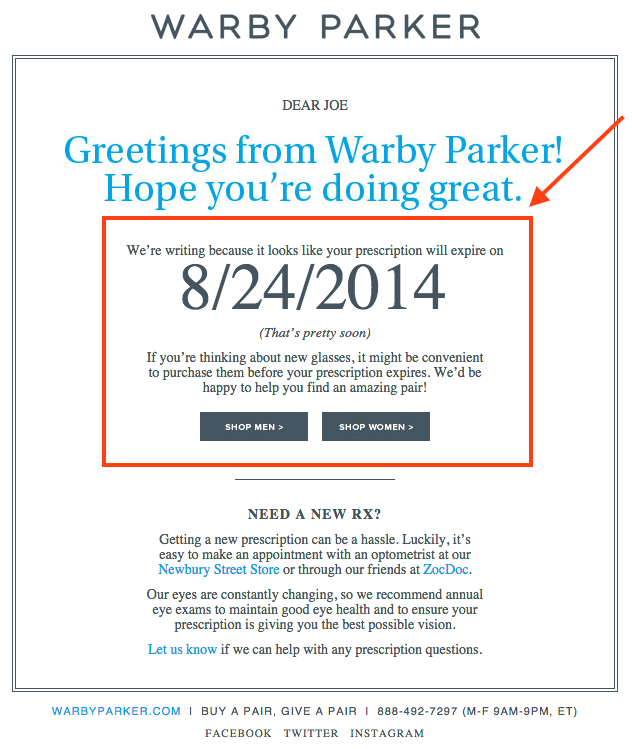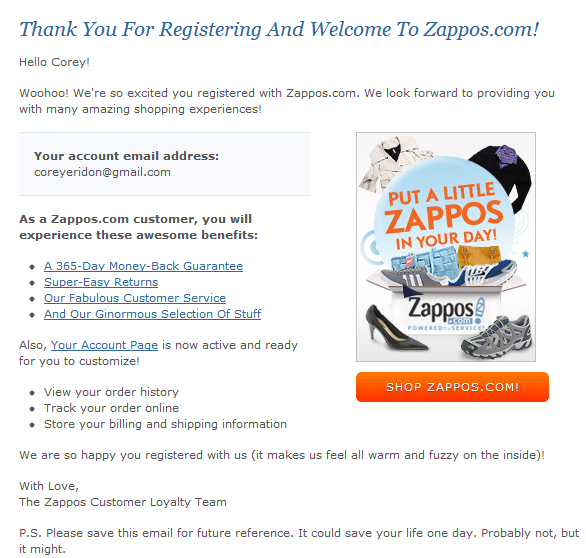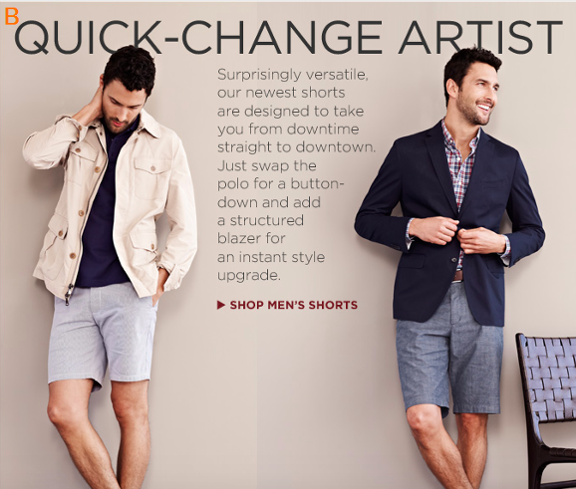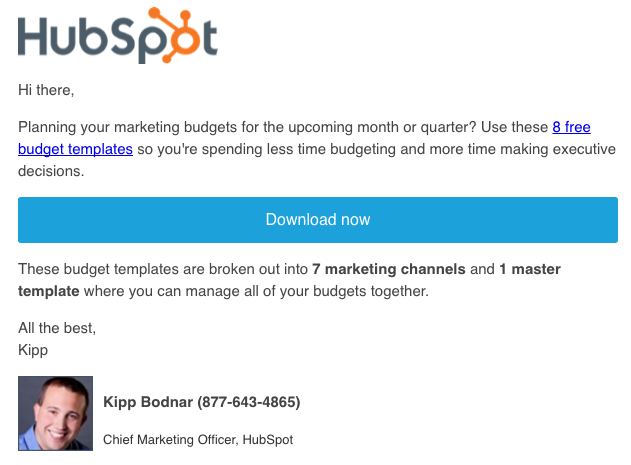Content marketing: how to write clear and minimally annoying email text

Over the past few years, much has changed in the field of email marketing . Today, companies use new marketing techniques, but you know what's funny? A simple correctly composed text of an e-mail can be as effective (if not more), like a heaped email with a bunch of “bells and whistles”.
Moreover, no matter how bright and colorful your letters are, if they don’t contain interesting content, subscribers will not read them.
')
So how do you create an attractive email? The rules of creating texts from HubSpot specialists will help you with this - below is an adapted translation of their notes on this topic.
10 rules for writing quality texts for email-letters
First we will talk about what the headlines should be, and then proceed to tips on writing the text of e-mails.
How to choose the right heading?
One of the key elements of an effective email is its header. He plays the role of the gatekeeper: no one will read your wonderful email if the title was not interesting enough. Despite the fact that there are conflicting statistics on how truly the headline affects the opening of letters, making it attractive and revealing the subject of the letter clearly does not hurt.
1) Call for action
The heading should call the reader to action. To do this, use verbs. For example, the restaurant reservation service OpenTable sent me an email, the title of which read: "Reduce your mom for lunch." Using the verb in the imperative mood (for example, “reduce”, “download”, “reserve”, “ask”, “buy”, etc.), you let the reader understand what he can do.
But there are other ways to encourage subscribers to take action. The task of the title is to inform the reader how the information in the letter can be useful for him, and whether it is worth opening it at all. In other words, the value of the letter to the subscriber should be your priority.
One day I received a letter from the TicketMaster reservation and purchase service with the headline "Do not miss the performance of Bruce Springsteen and the E Street Band." They did not call for me to buy a ticket by writing “Buy tickets for tomorrow's performance of Bruce Springsteen and E Street Band” (although such a headline could have worked), their variant showed how useful the information contained in the letter would be to me. Thanks to this, I prepared for the start of ticket sales at 10:00 and now I will go to the concert.
2) If possible, make letters personal
Personalized letters tend to have higher clickthrough rates [eng. click-through rate, CTR]. According to the research results of the Direct Marketing Association, segmented mailings and targeted letters bring 58% of all marketers' profits, and letters sent to specific target groups of subscribers - 36%.
There is nothing surprising. In the end, the more segmented the mailing list, the easier it is to create a personalized header and generate useful content for the email recipient.
Therefore, ask yourself the question: “Is it possible to make the title of my letter more personal?”. And this is not about adding the addressee’s name - this has long surprised no one.
Instead, let's look at this example. Suppose you are a realtor with a huge customer database ...
- Some of them want to rent property, others - to buy.
- People choose houses in several cities and microdistricts.
- All clients have different financial capabilities.
- Someone looking for a studio, and someone - a mansion.
- You even know that some of them only agree on houses that have been repaired in the last 5 years.
Of course, you will not send the same letter with the same heading to clients from different segments of your list, will you?
For example, one message could be titled: “1-room renovated apartment for rent in Cambridge: Hurry up and see”, and another one: “Come to an open view of the colonial house in Sudbury”. Each heading meets the different requirements of different segments of your list.
3) Clarity first, and only then “tenacity”
The title should be clear, not just catchy. When writing advertising text, clarity always comes first. If you come up with a clear title, you can make it funny, catchy or eccentric, then the flag is in your hands. But never put the entertainment aspect in the first place.
UrbanDaddy is one of those companies whose letter headers are always clear, interesting and funny. Here are some examples:
UD | Hotel in the middle of the ocean UD | Nunchuck from beer cans. Finally. UD | Gather All Together: Now It's Not So Tiring UD | Table-sized grill for table football UD | This is ice cream. This is a beer. This is a beer ice cream. UD | Private island in the Bahamas. Do what you like.
Some of these headers make the recipient smile, but they always make it very clear what the letter will be about. This brings us to the next point.
4) The title should reflect the content of the letter.
You need to know how important it is for the call to action to match the sentence on the landing page. The same principle should be followed when creating an email header and text.
What you promise the reader in the title should be disclosed in the text of the letter. If the recipient does not see the promise, the clickthrough rate may "suffer" (and in the long run, the rate of discovery will follow).
In 2011, we conducted our own research by sending the same email with different headers to two groups of people:
- "54 new informational slides for your presentation": click-through rate 26%
- "Be aware of the latest trends in marketing": the rate of clickability is 10.4%
Thus, the CTR of the first, more accurate and understandable headline exceeded the CTR of the second with a more vague wording by 15.6%.
This leads us to the idea that a high rate of discovery does not mean anything without a subsequent link to the links in the letter.
How to write a convincing message text
Now that you have selected an excellent headline, your audience’s attention is focused on the text of the email. So how do you write material that will interest them? Here are some important tips to follow!
5) Do not forget about the relevance
As well as the title, the text of the message should be relevant to the reader.
In this case, personalization is also not limited to writing the name of the recipient in circulation. In the introduction, explain to the reader how you met him.
This is an example of a letter from Warby Parker's online store of glasses to my colleague (by the way, the title of the letter was very good: “Oops, your prescription for glasses expires”).

Take a look at the first paragraph highlighted in red. Warby Parker marketers do not beat around the bush, but immediately inform the reader why they sent this letter - the prescription for glasses is expiring.
Now imagine that the letter would begin immediately with the second paragraph: “Getting a new recipe can cause a lot of trouble. Fortunately, you can easily make an appointment with an ophthalmologist in our store on Newbury Street or through the ZocDoc service. ”
... Why are you writing to me about a new recipe? Why should I listen to your advice? How did you know that I live next to Newbury Street? The client, who was reminded that in the past he had transferred his data to Warby Parker, is more likely to click on the link in the letter and make a purchase.
6) Use second person pronouns
In the text of the message, use the pronouns of the second person: “you”, “your” and “you”. For example: "Leaving the house in the morning, do not forget to take your jacket." Thus, the "focus" of the letter shifts towards the reader. Consider the text of the email from the online store Zappos:

Now count the number of times the pronoun “you” is used in this letter instead of “we” or “me”. So be it, you can not count: the words “you” and “your” are used 12 times, while “we”, “our” or “us” - only 5 times.
Such a number of second person pronouns helps to move the “focus” on the buyer, not on the brand. This tricky tactic will allow you to correctly prioritize, but the next point is particularly important.
7) Talk about the benefits of the product, not its properties.
You know the value of your letter. But does the recipient know it? No, not yet. And your task is to explain to him.
The problem is that most of the letters talk about the properties of products, and not about their benefits. Compare the texts of the two emails I received. Which of them explains the benefits for the client, and not just lists the properties of the product?


As you might have guessed, the correct answer is B. The first email simply offers a 30% discount, but does not indicate what the value of the GoDaddy product is to me. Will it allow optimizing infrastructure costs and saving money on hiring new employees? This advantage is far more tempting than a 30% discount on unspecified value.
Look at email B from the brand Banana Republic. His goal is to sell shorts, but there is no pressure on the reader. After all, it's just shorts, nothing special. But the brand emphasizes their advantage: versatility. The buyer can walk into them at home, and then, without changing clothes, go to the city. How convenient! How easy! How multifunctional!
In this case, the reader sees the benefit of acquiring short, and the text (or rather its absence) in an email from GoDaddy does not explain the advantage of a 30% discount.
8) Be brief
One of the blunders that copywriters make is to try to fit the whole story in one email. Remember how you check your mail? Do you read every word in the text? Hardly. Most likely, you quickly look through the content and look for key points to decide what to do next.
Therefore, if you are sending a text of hundreds of words, it will be much more difficult for recipients to decide whether they want to accept your offer. They will not be able to quickly assimilate all the information from the letter.
Instead, in a few sentences, try to convince the reader to follow the link to your website for more information.
Look at the concise email from the Postmates service, urging readers to take advantage of the special offer:

After a brief friendly greeting, Postmates marketers immediately move on to the distribution goal and inform customers about their new Free Latte on Demand promotion. After which they add a few important details, and then place a call to action button.
To write a short and informative text, you need to concentrate on your ultimate goal. If you know what exactly you want to achieve with your letter - so that subscribers can order a free latte, have time to buy a ticket for a Bruce Springsteen concert or go for a training session - it will be much easier for you to state the essence of your proposal in a concise form.
If for some reason you do not want to write a short message, remember that letters with a single call to action have higher clickthrough rates than letters with several CTA buttons.
9) Try to cause sympathy
The fact that emails are intended to transmit information does not mean that they cannot bring joy. In some cases, email can be used to present your brand in the best light and build relationships with customers. After all, the good attitude of people depends on your communication style.
Consider an email from the Death to Stock team. They sent a letter in order to apologize for having upset many of their customers during the previous mailing. Last time, they advertised a sold out product too quickly and did not indicate that they were not delivering to other countries.

Pay attention to the part of the letter in the red frame. In a brief form, they explain the situation, apologize for the mistake and promise that this will not happen again in the future, while at the same time offering the recipient several further actions to choose from.
Such a compressed email format is designed for a large number of subscribers who skim through content. Bold and one-line paragraphs increase the readability of the text. And finally, the marketers of Death to Stock are not afraid to add “personal” phrases to “humanize” their brand. As a result, subscribers are likely to forgive the company for this mistake.
10) Properly use calls to action
Yes, emails also use calls to action. At least in good letters. First of all, your appeal should attract attention. Remember: people are browsing mail fluently, and if you want to highlight any element of the letter - make it a call to action.
If you are sending an HTML email, you can add a call-to-action button, as AmazonLocal does:

An effective call-to-action button has the following qualities:
- Attractive design design: Notice how a huge bright orange button stands out against a blue background. Find it is not difficult.
- Clear text: The text on the button also plays an important role. Your call should be short and straightforward. The AmazonLocal button tells you what will happen if you click on it.
It is also worth taking the time to work out regular text messages. No matter how colorful your HTML-letter is, not every email client will display the images used in it. We decided to conduct a study and find out which letters are more effective. And although people say they prefer to receive HTML-letters with images, simple text letters bring the best result.
See how in one of our letters we used an anchor link to draw readers' attention to the call to action:

There are not so many graphics in this post compared to most HTML emails, so the hyperlink stands out even more. When readers view a text, their attention is drawn to bold words, images and hyperlinks. Thus, repeating your sentence again and again, you fail the reader to press the call to action button.
Other materials on the Pechkina blog:
- How to write a good text for a site or email-letter: WIIFM technology
- Email, social networks, instant messengers: What does the media influence and how to choose them
- How to create email-auto-answers: Analysis of 100 applications to support services of IT companies
- Working with email: How to reduce the number of incoming messages to zero
- Why spam is so hard to beat
- Email and Security: Is it possible to protect email correspondence?
Source: https://habr.com/ru/post/306502/
All Articles